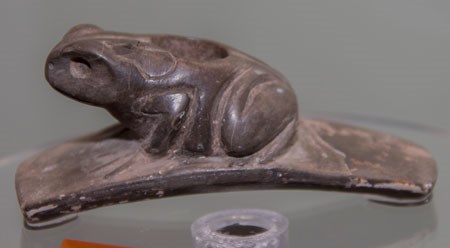Last updated: June 17, 2022
Article
Hopewell Culture Pipestone

NPS Photo
Written by Park Guide Sarah Hinkelman
Take a look at the artifact to the right. What does it look like to you? What colors and textures do you notice?
This artifact is called an effigy platform pipe. The word effigy means “in the shape of.” This particular pipe is in the shape of a bird and is made of pipestone! There are many different types of “pipestone” that the ancient artists in the Scioto River Valley used to make these magnificent pipes. The bird pipe in the photo is the only pipe found at Mound City Group that was made from catlinite pipestone, from Pipestone National Monument in Minnesota.
Most of the pipes found at Mound City in Hopewell Culture National Historical Park are made from local limestone, claystone, and claylike sedimentary rock deposits such as Ohio pipestone. All these sources can be found in southern Ohio—except for the one pictured above, which is made from catlinite from Minnesota. Pipes found at other Hopewell sites in the Scioto River valley are made from a variety of “pipe stones” including: Sterling Pipestone (another claylike deposit found in Illinois), Missouri flint clay, and catlinite a pipestone from the Pipestone National Monument in southwestern Minnesota. In reality, there is no one type of “pipestone.”

NPS Photo / Tom Engberg

NPS Photo / Tom Engberg
While there are many different sources, each stone is made up of very fine particles of sediment that have been fused together by heat and pressure. These rocks are considered “soft” because they can be carved relatively easily compared to other types of stone. The ancient artists who created the pipes found in the earthworks in the Scioto River Valley likely used tools like flint blades and knives to carve the stone into birds, beavers, otters, turtles, frogs, raccoons, wolves, and many other animals that were native to North America!
These different stones occur in a wide variety of colors from black and grey to bright pinks and reds. They can also be heated to change the color of the stone. These rich colors make for vibrant artifacts and the detail in the carving makes the animals the pipes represent come to life.
These pipes were used to smoke tobacco (Nicotiana rustica) as part of a religious celebration. It was likely that the people who participated in the Hopewell culture viewed effigy pipes as living things and used them specifically to pray during ritual ceremonies. According to present day American Indian tradition, the smoke from the pipe is thought to carry prayers to the spirits beyond the realm of the living. Many of these pipes found at Mound City Group were intentionally broken, possibly representing the release of the pipe’s spirit 2,000 years ago. American Indian tradition also indicates that the act of quarrying pipestone was a spiritual activity as well, it required acts of reverence including making offerings of tobacco. Still today, pipes are used by American Indians continuing the long tradition of creating pipes and appreciating their sacred power in prayer and ceremony.
For more information on pipestone and the use of pipes in American Indian culture and tradition visit Pipestone National Monument! Regrettably, if you would like to see most of the pipes from Mound City Group, you will have to take a trip to the British Museum where most of the pipes are kept because of an unfortunate sale in the nineteenth century.
